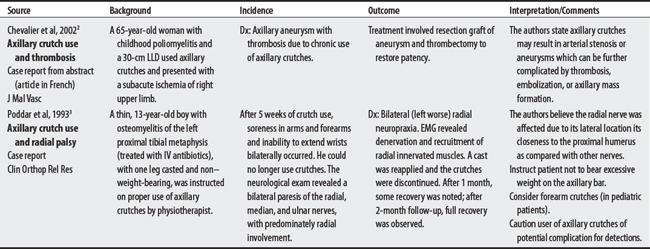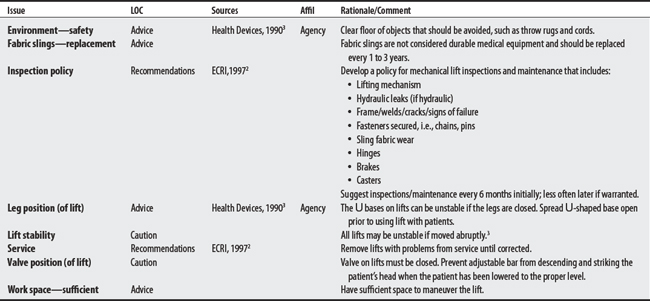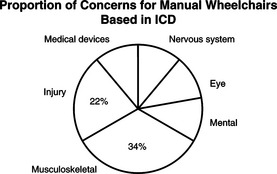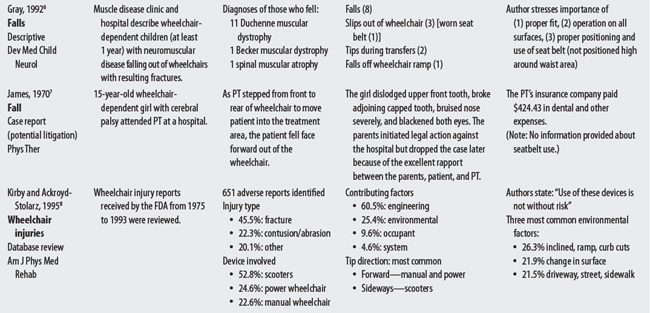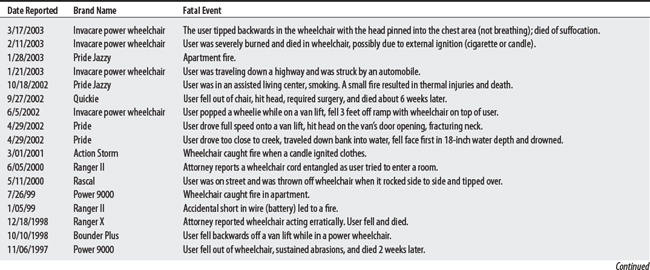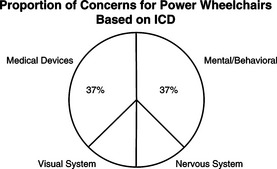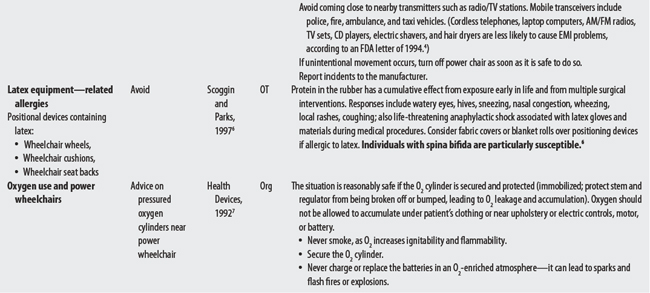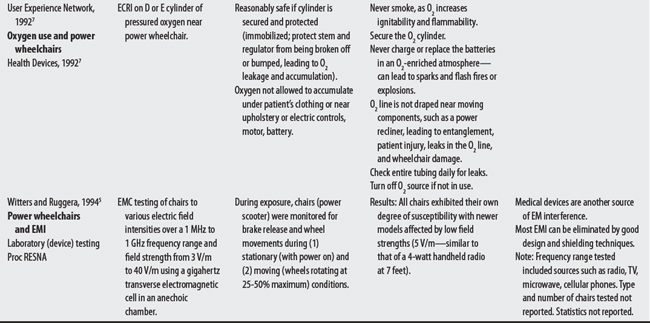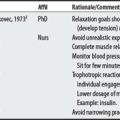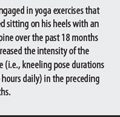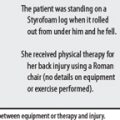Chapter 29 Assistive Devices
OVERVIEW.
Canes are wooden or metal walking devices that are held in one hand and designed to aid in stability and to “take some of the weight off one foot.”1 Straight and quad canes offer one and four points of support, respectively. Hemi-walkers (walk-canes) offer four points of support with a wider base than that provided by a quad cane.2
SUMMARY: PRECAUTIONS.
Some procedural concerns relate to proper fitting and appropriate use of canes. For example, canes are not designed to unweight a limb of a patient with a protected weight-bearing status. Twenty-six cane-related injuries were reported to the FDA from December 1990 to November 2002; the majority of injuries involved quad canes. Three quad cane-related deaths were reported to the FDA between 1997 and 2003.3
ADVERSE EVENTS
FOOD AND DRUG ADMINISTRATION REPORTS
FDA: Cane-Related Fatalities3
| Date of Report | Brand | Fatal Event (death) |
|---|---|---|
| 1/14/03 | Quad cane large base | A dialysis patient’s foot slipped under the base of the cane, resulting in a sprained ankle and fractured right patella. Following foot slipped under the base of hospitalization, the patient was transferred to a skilled nursing facility for rehabilitation and died from complications due to an unrelated health condition. |
| 2/12/01 | Adjustable quad cane | Attorney alleged that while an individual used a quad cane, it snapped, and the individual fell, sustaining injury that subsequently led to death (no details). |
| 2/04/97 | Adjustable quad cane | Attorney reported that while an individual was using a quad cane to rise from a chair, the cane snapped and the individual fell, suffering a fractured spine. The individual subsequently died. |
Note: Cane-related deaths. MDR and Maude3 reported deaths.
1 Eisenberg MG. Dictionary of rehabilitation. New York: Springer, 1995.
2 Miller-Keane encyclopedia and dictionary of medicine, nursing, and allied health. ed 7. Philadelphia: W.B. Saunders; 2003.
3 U.S. Food and Drug Administration. Center for Device and Radiological Health. Available at: http://www.fda.gov/cdrh/mdr/. Accessed November 7, 2005
4 Tan JC. Practical manual of physical medicine and rehabilitation: diagnostics, therapeutics, and basic problems. St. Louis: Mosby, 1998.
5 Pierson FM, Fairchild SL. Principles and techniques of patient care, ed 3. Philadelphia: Saunders, 2002.
6 Sainsbury R, Mulley G. Walking sticks used by the elderly. BMJ. 1982;284:1751.
7 Pain H, McLellan L, Gore S. Choosing assistive devices: A guide for users and professionals. London: Jessica Kingsley, 2003.
8 Schmitz TJ. Preambulation and gait training. In O’Sullivan SB, Schmitz TJ, editors: Physical rehabilitation and treatment, ed 4, Philadelphia: F.A. Davis, 2001.
29.2 Crutches
OVERVIEW.
Crutches are wooden or metal walking devices that extend from the floor to the vicinity of the elbow or the axilla. Axillary crutches terminate proximally with cross bars near the user’s axilla, whereas forearm crutches (Loftstrand) end proximally with hinged open cuffs located just below the elbow.1
SUMMARY: CONTRAINDICATIONS AND PRECAUTIONS.
Crutch concerns tend to be either musculoskeletal (arthritis, weakness), device-related (worn tips), or procedural (improper use of crutches). Cases report poor crutch usage, which has resulted in vascular (thrombosis) or neurological complications (neuropraxia).2,3
OTHER ISSUES.
Note 1: Mechanical failure: While great emphasis has been placed on monitoring crutch tips for wear, the majority of crutch-related injuries reported to the FDA appear to have been mechanical failure-related (e.g., metal cracking, bolt failure). Only seven of 38 reported incidences involved the patient slipping.4
CONTRAINDICATIONS AND PRECAUTIONS
M00-M99 DISEASES OF THE MUSCULOSKELETAL SYSTEM AND CONNECTIVE TISSUE
1 Eisenberg MG. Dictionary of rehabilitation. New York: Springer, 1995.
2 Chevalier J, Joly P, Dhoine P. Axillary aneurysm and crutches. J Mal Vasc. 2002;27(1):36-38.
3 Poddar SB, Gitelis S, Heydemann PT, et al. Bilateral predominant radial nerve crutch palsy. A case report. Clin Orthop Rel Res. 1993;297:245-246.
4 US Food and Drug Administration. Center for Device and Radiological Health. Available at: http://www.fda.gov/cdrh/mdr/. Accessed November 7, 2005
5 Schmitz TJ. Preambulation and gait training. In O’Sullivan SB, Schmitz TJ, editors: Physical rehabilitation and treatment, ed 4, Philadelphia: F.A. Davis, 2001.
6 Tan JC. Practical manual of physical medicine and rehabilitation: diagnostics, therapeutics, and basic problems. St. Louis: Mosby, 1998.
7 Pain H, McLellan L, Gore S. Choosing assistive devices: A guide for users and professionals. London: Jessica Kingsley, 2003.
8 Pierson FM, Fairchild SL. Principles and techniques of patient care, ed 3. Philadelphia: Saunders, 2002.
29.3 Lifts, Mechanical
OVERVIEW.
A mechanical lift is a hydraulic-, battery-, or mechanically powered device used to lift and transfer or transport a patient in the horizontal or other required position from one place to another. The device includes straps and a sling to support the patient.1
SUMMARY: CONTRAINDICATIONS AND PRECAUTIONS.
Mechanical lift concerns are either device-related (appropriate model for the task) or procedural-related (proper use of the device during transfers; proper maintenance).2,3 Thirty-two lift-related deaths have been reported to the FDA from 1990 to 2002. In almost 80% of these cases, deaths were sling or strap related.1
FDA1 MECHANICAL LIFT-RELATED DEATHS
| Dates | Outcome | Possible Contributing Factors |
|---|---|---|
| MDR 7/26/96-8/31/90 and Maude 9/23/96-3/14/2002 | 34 deaths |
29.4 Vibratory Devices
CONTRAINDICATIONS AND PRECAUTIONS
G00-G99 DISEASES OF THE NERVOUS SYSTEM
I00-I99 DISEASES OF THE CIRCULATORY SYSTEM
1 Eisenberg MG. Dictionary of rehabilitation. New York: Springer, 1995.
2 Umphred DA. Classification of treatment techniques based on primary input systems: Inherent and contrived feedback/loops systems and their potential influence on altering a feedforward motor system. In: Umphred DA, editor. Neurological rehabilitation. St. Louis: Mosby, 1995.
3 Bishop B. Vibration stimulation II. Vibratory stimulation as an evaluation tool. Phys Ther. 1975;55:29-33.
29.5 Walkers
OVERVIEW.
A walker is a mechanical device with four legs and a metal frame used to provide moderate weight support while ambulating.1
SUMMARY: CONTRAINDICATIONS AND PRECAUTIONS.
Adult walker concerns tend to be procedural2–4 (e.g., using the device properly, monitoring it for wear). Other concerns are device-related (i.e., difficulty in managing a component part).2 Three deaths and about 133 injuries have been reported to the FDA over a 14-year period (from 11/11/91 to 8/06/04).1 In a separate matter, both the American Academy of Pediatrics5,6 and the Consumer Product Safety Commission7 have voiced grave safety concerns over use of infant (baby) walkers, where 34 related deaths have occurred from 1973 to 2001.
CONTRAINDICATIONS AND PRECAUTIONS
M00-M99 DISEASES OF THE MUSCULOSKELETAL SYSTEM AND CONNECTIVE TISSUE
1 U.S. Food and Drug Administration. Center for Device and Radiological Health. Available at: http://www.fda.gov/cdrh/mdr/. Accessed November 7, 2005
2 Pain H, McLellan L, Gore S. Choosing assistive devices: A guide for users and professionals. London: Jessica Kingsley, 2003.
3 McConnell EA. Clinical do’s and don’ts: teaching your patient to use a stationary walker. Nursing. 2001;31(10):17.
4 Schmitz TJ. Preambulation and gait training. In O’Sullivan SB, Schmitz TJ, editors: Physical rehabilitation and treatment, ed 4, Philadelphia: F.A. Davis, 2001.
5 American Academy of Pediatrics Committee on Injury and Poison Prevention. Injuries associated with infant walkers. Pediatrics. 2001;108(3):790-792.
6 Siegel AC, Burton RV. Effects of baby walkers on motor and mental development in human infants. J Dev Behav Pediatr. 1999;20(5):355-361.
7 Consumer Product Safety Commission. CPSC gets new, safer baby walkers on the market, CPSC Document # 5086. Available at: http://www.cpsc.gov/CPSCPUB/PUBS/5086.pdf. Accessed November 17, 2005
8 Medical Devices Agency. Rollators: risk of collapse and other issues, SN 2001 (16). London: Medical Devices Agency; 2001. Available at: http://www.medical-devices.gov.uk. Accessed November 7, 2005
29.6 Manual Wheelchairs
OVERVIEW.
A manual wheelchair is a locomotor device consisting of a seat and wheels which can be self-propelled or pushed by an attendant.1
SUMMARY: CONTRAINDICATIONS AND PRECAUTIONS.
Few authorities have published contraindication guidelines for wheelchairs. Tan2 mentions nine concerns, three of which are absolute: poor judgment, blindness, and ischial ulcers. The largest proportion of concerns are musculoskeletal related. Three concerns appear directed toward individuals who either self-propel (i.e., visual concerns) or only have access to standard wheelchairs (i.e., devices that may not address postural defects or trunk weakness).
CONTRAINDICATIONS AND PRECAUTIONS
F00-F99 MENTAL AND BEHAVIORAL DISORDERS
G00-G99 DISEASES OF THE NERVOUS SYSTEM
M00-M99 DISEASES OF THE MUSCULOSKELETAL SYSTEM AND CONNECTIVE TISSUE
S00-T98 INJURY, POISONING, AND CERTAIN OTHER CONSEQUENCES OF EXTERNAL CAUSES
ADVERSE EVENTS
STAIR-CLIMBING WHEELCHAIR-RELATED INJURIES
FDA Reports1
| Date of Report | Brand | Event |
|---|---|---|
| 8/08/88 | Quadra stair-climbing wheelchair | The user fell and fractured the hip when a wheel came off the unit while on the stairs. |
| 12/30/86 | Model 40 stair | A rivet that holds the handles on came loose and resulted in a fall but no injuries. |
FDA Reports: Stair-climbing wheelchair (IMK)
WHEELCHAIR-RELATED FATALITIES
FDA Reports1: Fatalities
| Date of Report | Brand | Fatal Event |
|---|---|---|
| 11/21/2002 | Breezy | User did not engage wheel locks, rolled down a slope, could not stop, and ran into a metal fence. The user sustained multiple fractures and, after 2 months, developed a lung infection. |
| 11/20/02 | Activx | User fell rearward from wheelchair in exercise room of a nursing home. Push canes were broken. Anti-tippers had been cut down to increase clearance for attendant. |
| 10/17/02 | Wheelchair, transport | User fell backward and hit head. |
| 11/19/2001 | Quickie | User was transported from school to home, did not recline wheelchair or secure with pin, and fell off lift. The wheelchair tipped forward and user hit head, developed a hematoma, and died 5 days later. |
| 09/11/01 | Invacare manual wheelchair | User fell out of wheelchair and hit head. |
| 02/22/01 | Tracer | User tipped out of wheelchair while traveling in a van, fractured leg and subsequently died. The wheelchair was not properly secured in the van and tipped over when the van took a sharp turn. |
| 07/10/00 | Mechanical wheelchair | An attendant transported wheelchair backwards up a ramp. The left handgrip came off the wheelchair and wheelchair rolled down a ramp and tipped. The user hit head. |
| 02/24/99 | Quickie P210 | Wheelchair overturned on patient, pinning patient and crushing throat, resulting in traumatic asphyxia. |
| 11/05/98 | Ride-Lite 9000 | User dropped lighter on lap and was engulfed in flames. |
| 10/31/98 | Rolls 1000 | User dropped a burning sponge curler on lap. |
| 12/22/97 | Ride-Lite 9000 | Short sleeve caught on fire when user was in contact with burning stove. User sustained second- and third-degree burns and later died. |
| 08/15/97 | Tracer | Patient found out of chair on floor, wheelchair tipped forward, and seat belt around neck, allegedly resulting in death. |
| 07/31/96 | Rolls 1000E | User was transported in a van using a “tie down” system (manual warned against this manner of transportation). The rear wheel bent and the user struck her head on side of the van. A head injury and death ensued. |
| 10/25/95 | Quickie manual wheelchair | A child pulled own feet out of restraint, slid down the chair, and was caught on the position belt; child suffered positioning asphyxia. |
| 09/21/94 | Quickie | While crossing a threshold from room to room, a wheelchair flipped backwards and the user fractured a rib. |
| 08/26/93 | Rolls 4000 | User was sitting at the front edge of the seat, leaned forward to pick up something, tipped the wheelchair and struck head on floor. The user developed cerebral edema and expired 3 days later. The chair was equipped with front anti-tippers. |
| 04/26/91 | Quickie wheelchair | Attorney alleged user slid down chair and strangled by chest brace on wheelchair. |
| 09/18/86 | E & J | Attorney alleges wrongful death in rehab center involving a wheelchair. No details. |
Note: FDA reports do not necessarily establish cause-effect relationships between equipment and injury. Incidents may be due to equipment or user error. Also, some reports are alleged by attorneys.
1 U.S. Food and Drug Administration. Center for Device and Radiological Health. Available at: http://www.fda.gov/cdrh/mdr/. Accessed November 7, 2005
2 Tan JC. Practical manual of physical medicine and rehabilitation: diagnostics, therapeutics, and basic problems. St. Louis: Mosby, 1998.
3 Scoggin AE, Parks KM. Latex sensitivity in children with spina bifida: implications for occupational therapy practitioners. Am J Occup Ther. 1997;51(7):608-611.
4 American Academy of Pediatrics, Committee on Injury and Poison Prevention. School bus transportation of children with special health care needs. Pediatrics. 2001;108(2):516-518.
5 Dudley NJ, Cotter DHG, Mulley GP. Wheelchair-related accidents. Clin Rehab. 1992;6(3):189-194.
6 Gray B, Hsu JD, Furumasu J. Fractures caused by falling from a wheelchair in patients with neuromuscular disease. Dev Med Child Neurol. 1992;34(7):589-592.
7 James CAJr. Medico-legal considerations in the practice of physical therapy. Phys Ther. 1970;50(8):1203-1207.
8 Kirby RL, Ackroyd-Stolarz SA. Wheelchair safety—adverse reports to the United States Food and Drug Administration. Am J Phys Med Rehab. 1995;74(4):308-312.
9 Ummat S, Kirby RL. Nonfatal wheelchair related accidents reported to the National Electronic Injury Surveillance System. Am J Phys Med Rehab. 1994;73(3):163-167.
10 Calder CJ, Kirby RL. Fatal wheelchair-related accidents in the United States. Am J Phys Med Rehab. 1990;69(4):184-190.
29.7 Power Mobility (Power Wheelchairs and Scooters)
OVERVIEW.
A powered wheelchair is a battery-operated device with a frame and wheels that is used to provide locomotion to persons restricted to a sitting position.1 Power scooters (i.e., golf cart–like devices), which generally require better manipulative, transfer, and sitting skills than power wheelchairs, are also included under Adverse Events.
ADVERSE EVENTS
FDA REPORTS1
Power Wheelchair–Related Fatalities
| Date Reported | Brand Name | Fatal Event |
|---|---|---|
| 3/17/2003 | Invacare power wheelchair | The user tipped backwards in the wheelchair with the head pinned into the chest area (not breathing); died of suffocation. |
| 2/11/2003 | Invacare power wheelchair | User was severely burned and died in wheelchair, possibly due to external ignition (cigarette or candle). |
| 1/28/2003 | Pride Jazzy | Apartment fire. |
| 1/21/2003 | Invacare power wheelchair | User was traveling down a highway and was struck by an automobile. |
| 10/18/2002 | Pride Jazzy | User was in an assisted living center, smoking. A small fire resulted in thermal injuries and death. |
| 9/27/2002 | Quickie | User fell out of chair, hit head, required surgery, and died about 6 weeks later. |
| 6/5/2002 | Invacare power wheelchair | User popped a wheelie while on a van lift, fell 3 feet off ramp with wheelchair on top of user. |
| 4/29/2002 | Pride | User drove full speed onto a van lift, hit head on the van’s door opening, fracturig neck. |
| 4/29/2002 | Pride | User drove too close to creek, traveled down bank into water, fell face first in 18-inch water depth and drowned. |
| 3/01/2001 | Action Storm | Wheelchair caught fire when a candle ignited clothes. |
| 6/05/2000 | Ranger II | Attorney reports a wheelchair cord entangled as user tried to enter a room. |
| 5/11/2000 | Rascal | User was on street and was thrown off wheelchair when it rocked side to side and tipped over. |
| 7/26/99 | Power 9000 | Wheelchair caught fire in apartment. |
| 1/05/99 | Ranger II | Accidental short in wire (battery) led to a fire. |
| 12/18/1998 | Ranger X | Attorney reported wheelchair acting erratically. User fell and died. |
| 10/10/1998 | Bounder Plus | User fell backwards off a van lift while in a power wheelchair. |
| 11/06/1997 | Power 9000 | User fell out of wheelchair, sustained abrasions, and died 2 weeks later. |
| Date Reported | Brand Name | Fatal Event |
|---|---|---|
| 8/25/1997 | Arrow | User was struck by a truck while on a dark street (owner’s manual warns against driving on streets or highways). |
| 2/11/1997 | P100 Power Wheelchair | User was on wheelchair while charging battery exploded, severely injuring user. |
| 10/11/1996 | Arrow XT | Attorney reported fire, smoke inhalation, and death. Also noted: unauthorized components used. |
| 8/17/95 | Max 30/Permobil | Charger/cable caused fire on wheelchair, fire in room, and death. |
| 10/5/94 | Rascal convertible | A female user with multiple sclerosis misjudged position of step, ran front wheels off steps, and fell down steps (reported by husband). |
| 4/9/90 | Everest & Jennings | Wife found husband in back yard, possibly dead from positional asphyxia. Wheelchair reported broken. |
Note: FDA reports do not necessarily establish cause-effect relationship between equipment and injury. Incidences may be due to equipment or user error. Also, some reports are alleged by attorneys.
Scooter-Related Fatalities1
| Date Reported | Brand Name | Fatal Event |
|---|---|---|
| 1/28/03 | Pride Scooter | Fire in the garage. |
| 7/31/02 | Rascal 3W | Tipped over in yard. |
| 3/20/02 | Rascal | The user was struck from behind and was thrown from the unit. |
| 1/03/02 | Chauffeur 3W | No details. |
| 10/15/01 | Rascal | The user was hit by a vehicle while crossing an intersection. |
| 4/06/01 | Golden companion | Lift contributed to accident. |
| 12/21/00 | Vehicle (4-wheel) | Unit traveling too fast down hill and turned sharply, falling on top of user. Hospitalized 2 weeks and died. |
| 10/24/00 | Pride | No details. |
| 10/27/99 | Pacesaver | Struck by car while crossing a highway at night. Manual warns against driving on busy streets. |
| 6/4/99 | Pacesaver | Run over by a large truck situated 6 inches in front of scooter. Location: construction site. Driver did not see user. |
| 4/19/99 | Tri-rolls | Attorney reports brakes failed. |
| 3/4/99 | Ranger “Solo” | Attorney reports user fell off unit, developed pneumonia. |
| 12/02/98 | Pride Shuttle | User unable to travel up hill due to low battery. Then backed down hill backwards by placing unit in neutral without brakes, hit curb backwards, fell on curb and sidewalk. |
| 10/29/98 | Pride | No details. |
| 10/29/98 | Brand unknown | Husband allegedly wired unit to accommodate a second battery in order to secure a quicker charge. |
| 10/09/98 | Rascal | Unit on lawn near sloped area, flipped over on patient, puncturing lung. |
| 9/23/98 | Rascal | User fell and hit head. The device’s tiller arm was loose and unstable. A new one was on order. Cautioned not to use. |
| 12/23/97 | Sterling | While user was crossing railroad tracks, a wheel became stuck in gap and the user was struck by train. |
| 8/30/96 | Pacesaver | A street sweeper traveling on northbound lane but going in reverse did not see scooter and hit it. |
| 3/21/96 | Scout | An 81-year-old person with COPD found next to scooter with O2 line entangled and cut under unit. |
| 7/29/94 | Bravo | An 81-year-old tipped unit, fell, and fractured hip; the patient developed a blood clot 3 months s/p repair. |
| 2/28/94 | Amigo RWD | User sitting in unit; unit caught fire. |
| 2/8/94 | Lark | User purchased a refurbished unit. On the way home, it tipped in street and user hit head. |
| 9/22/92 | Pace Saver Excel | User drove backwards off subway platform and into a high-voltage line. |
| 3/24/92 | Amigo FWD | User negotiated a steep, narrow ramp covered with artificial turf. The unit overturned. The user struck head, was hospitalized, and developed pneumonia. |
| 7/12/90 | Bravo | An 86-year-old female with emphysema fell, fractured a hip, and died 5 days later. A wheel had detached due to a broken weld. |
| 8/19/88 | Rascal | A traffic light changed while user was crossing street; user was struck by car. |
| 12/23/86 | Rascal | An attorney reported seat post ripped out of engine housing. It had been previously repaired by an unauthorized company. |
| 12/16/86 | Rascal | User tipped backwards at home. |
| 11/06/86 | Rascal 3W | While ascending a ramp at a grocery store, user fell sideways off ramp. |
Note: FDA reports do not necessarily establish cause-effect relationships between equipment and injury. Incidences may be due to equipment or user error. Also, some reports are alleged by attorneys.
1 U.S. Food and Drug Administration. Center for Device and Radiological Health. Available at: http://www.fda.gov/cdrh/mdr/. Accessed November 7, 2005
2 Tan JC. Practical manual of physical medicine and rehabilitation: diagnostics, therapeutics, and basic problems. St. Louis: Mosby, 1998.
3 Greenbaum MG, Fernandes S, Wainapel SF. Use of a motorized wheelchair in conjunction with a guide dog for the legally blind and physically disabled. Arch Phys Med Rehab. 1998;79(2):216-217.
4 Alpert S. Dear Powered Wheelchair/Scooter or Accessory/Component Manufacturer [letter]. Center for Devices and Radiological Health. Department of Health and Human Services. Public Health Services, FDA, May 26, 1994.
5 Witters DM, Ruggera PS: Electromagnetic compatibility (EMC) of powered wheelchairs and scooters. Proceedings of the RESNA 1994 Annual Conference, June 17-22, 14:359-360, 1994.
6 Scoggin AE, Parks KM. Latex sensitivity in children with spina bifida: implications for occupational therapy practitioners. Am J Occup Ther. 1997;51(7):608-611.
7 User Experience Network. safe use of supplemental oxygen with powered wheelchairs. Health Devices. 1992;21(8):291.
8 Becker DG, Washington BV, Devlin PM, et al. Injury due to uncontrolled acceleration of an electric wheelchair. J Emerg Med. 1991;9(3):115-117.







